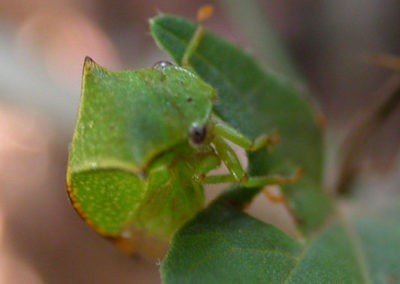Native to North America, the buffalo treehopper, Stictocephala bisonia, was introduced into Europe in the 19th century. It causes reddening of the leaves or traumatic reddening by piercing the canes to lay its eggs.
2.4.3.b Buffalo treehopper
What damage does the buffalo treehopper cause in the vineyard?
The insects feeding by biting does not cause significant damage to grapevines even if it may appear significant. By hindering sap circulation, the incisions made by the females and larval bites can cause, in late summer or autumn, a red colouration of the upper parts of the canes. However, wounds resulting from oviposition heal poorly and resemble hail marks. These wounds can weaken young vines after several years of infestation. The symptoms, which combine reddening and curling, can resemble those of flavescence dorée but remain on the upper parts of the branches, above the site where the incision was made.
How to identify a bubale leafhopper?
The adults are green with an unusual shape and measure 8 to 10 mm in length. The first segment of the thorax (pronotum) is strongly developed forming two horn-like protrusions. At their base, the forewings are coriaceous with white flecks. The larvae are brownish-grey and have a strange appearance with fan-shaped hooks on their backs. Both larval and adult forms move slowly on vegetation.
What is the biology of the buffalo treehopper?
The buffalo treehopper requires two hosts: herbaceous species for larvae and adult development (clover, alfalfa, potato, plantain, dandelion, etc.), and woody species (young vine branches, apple trees) for oviposition which takes place between August and September.
The larvae hatch from mid-May to mid-June and drop to the ground. The five larval stages occur on herbaceous plants without inflicting serious damage. Adults appear from mid-July to mid-August and can then be observed in vineyards and orchards. After cutting lengthwise the bark of wood that is usually between one to three years old, the female lays about six eggs on each side of the incision.
What treatments are available?
On grapevines, it is not generally necessary to chemically control buffalo treehoppers, but conventional insecticide use can limit the damage in the event of a large local invasion.
This chapter is an extract from Vigne Vin Occitanie.


